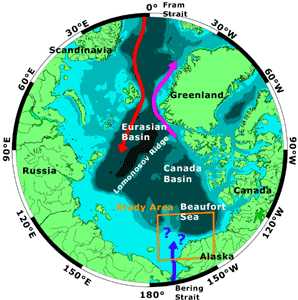|
|
 |
Images and Facts - Facts
Gallery | Dispatch Images | Facts | References
Oceanography
by Bob Pickart
The Arctic Ocean is unique among the world’s oceans for many
reasons. It is largely ice-covered (much of it year-round, the rest
seasonally) and it has an abnormally high ratio of shelf to abyssal
area. It receives about 10% of the global river runoff, but because
of its small size (it contains 2% and 5% of the global ocean volume
and area, respectively) and the low temperatures that prevail throughout
the Arctic Ocean, salinity plays the dominant role in establishing
density. Thus the small volume (area) to large runoff fraction is
important to this ocean. Although the interior of the Arctic ocean
is small, it contains deep basins which are separated by a series
of ridges. The most pronounced is the Lomonosov Ridge, which separates
the eastern Arctic (the Eurasian Basin) from the western Arctic (the
Canada Basin).
 |
 |
| Arctic Ocean circulation.
Arrows indicate currents. Blue arrow is Pacific inflow, red
arrow is warm Atlantic inflow, magenta arrow is cold Arctic
outflow. |
| Click
to enlarge. |
The Arctic Ocean is largely isolated from the rest of the world ocean
by land. The two major openings are Fram Strait, between Greenland
and the Norwegian Island of Svalbard, and Bering Strait, between Russia
and Alaska. (The former is the only deep passage into the Arctic.)
Warm “Atlantic Water” (red arrow on map) flows through
Fram Strait and the neighboring Barents Sea; this is water which originally
came from the Gulf Stream. Once in the Arctic, this water is cooled
as it travels cyclonically around the perimeter as a boundary current,
finally exiting Fram Strait as a colder, fresher water mass (magenta
arrow on map). This warm-to-cold conversion is a crucial component
of the global ocean’s overturning circulation that helps maintain
the earth’s climate.
As a result of the influx of Atlantic Water, the mid-depth layer of
the Arctic ocean is filled with warm water. In fact, there is more
than enough heat stored in this water to melt the polar ice cover
from below. The reason this does not happen is because of a relatively
thin layer of cold, salty water overlying the Atlantic Water. This
layer is called the halocline, and it acts as a shield protecting
the ice. What is the origin of the halocline? While there is no definitive
answer, oceanographers believe that the water maintaining the halocline
most likely originates from the shelf, somehow injected laterally
into the deep basins. Part of the halocline water comes from the “Pacific
Water” entering through Bering Strait (blue arrow on map). This
water, which starts out fresh, is transformed by a process known as
brine rejection. The cold arctic air freezes the water, thereby removing
freshwater (contained in the ice), leaving behind heavier, saltier
water which sinks and enters the halocline. The winds strongly affect
this process. Winds also drive a system of currents throughout the
Arctic.
This complex system in the Arctic---which impacts the
entire food web---is in a delicate balance that will likely be upset by
climate change. As such, the Arctic Ocean is the focus of intense
study by oceanographers of all disciplines.
Back to Facts Index
|
|




